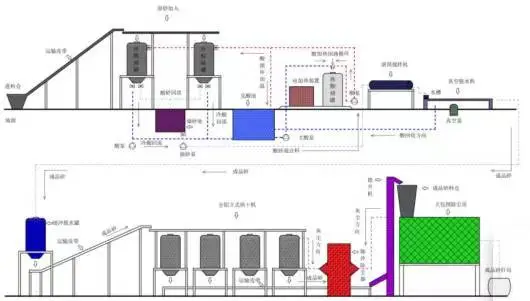


The production process of quartz sand (2-140 mesh) for quartz Slab is as follows:
silo—transport—acid addition—acid reaction—deacidification—dehydration—drying—screening—packaging the finished product.
The whole process can be completed within 24 hours, which can completely wash the yellow, black, red, etc. of the quartz sand surface, increase the silica content of the quartz sand, reduce the impurity content, and further enhance the product value.
China’s artificial quartz production technology began to gradually mature after 2010, and began to gradually replace acrylic artificial stone as the main material in kitchen countertops and other fields by virtue of its advantages in performance and price. Huge market potential. With the fierce competition in the quartz slab market, the quality and performance requirements of the quartz slab customers are getting higher and better.
1.Slab sand purification process: pickling
On the one hand, the whiteness and transparency of quartz sand will directly affect the color effect of the slab. The same color formula will have a large difference in the color effect on powders with different whiteness. It can be said that the impurities and purity of quartz sand directly affect the surface effect of the slab. At present, the sand used for quartz stone slabs has high requirements for whiteness, generally requiring whiteness to reach more than 90%, and higher requirements to reach more than 95%.
On the other hand, with the mining of quartz ore, there are fewer and fewer high-quality quartz resources. Impurity elements in quartz ore will significantly affect the performance of quartz products, such as iron and other transition metals will affect the light transmittance and electrical conductivity of quartz products; excessive content of alkali metal impurities such as potassium and sodium will reduce the high temperature resistance of quartz products. This in turn affects its thermal stability and optical properties.
At present, the purification methods of quartz sand include magnetic separation, acid washing, flotation, microbial method and complex method. Among them, pickling can remove some acid-soluble metal oxides and some silicate minerals. Moreover, the quartz sand (pickling sand) obtained by pickling does not have particularly high requirements on the ore source, and has huge advantages in terms of supply and price, so it is an important choice to replace quartz fine sand for the production of artificial quartz stone panels.
Comparison of the effect of quartz sand before and after pickling
2.Factors affecting the pickling effect of plate sand
The pickling process is actually the process of removing impurities by chemical reaction with acid, thereby improving the purity of quartz sand. Acidity, time, temperature, pickling, process and equipment are the main factors affecting the effect of pickling.
Acids commonly used in acid leaching include sulfuric acid, hydrochloric acid, nitric acid, and hydrofluoric acid. Dilute acid has good removal effect on impurities such as iron, aluminum and magnesium, while concentrated sulfuric acid and hydrofluoric acid have good removal effect on titanium and chromium impurities. In actual beneficiation, compared with a single type of acid, mixed acid can produce a synergistic effect, the removal rate is higher, and the purification effect is the best.
At present, the common environmentally friendly pickling formulas for quartz sand in the industry include oxalic acid + ammonium bifluoride, oxalic acid + hydrofluoric acid, etc. Some enterprises also use strong acids such as sulfuric acid and hydrochloric acid for pickling. The strong acid is very harmful to the sand, and it cannot be washed off cleanly.
The environmental protection pickling method of quartz sand needs to be adjusted according to the selectivity, molecular structure, density, crystal, impurity element content and other elements of quartz sand in actual production, and some other additives can also be added according to product requirements, such as seven Water and ferrous sulfate, etc., can whiten quartz sand.
3.Pickling equipment for slab sand
The most special pickling process is hydrofluoric acid. Hydrofluoric acid has its own unique corrosion behavior. Quartz and granite have excellent corrosion resistance in sulfuric acid, nitric acid and hydrochloric acid, but they are powerless in the face of HF. Even epoxy resins and furan resins with excellent acid resistance will form fluorides in hydrofluoric acid solution, resulting in a significant decrease in strength and failure of protection. Therefore, the selection of hydrogen fluoride-resistant materials has always been a topic of great concern to the anti-corrosion of pickling equipment.
To find out more about our products and solutions, please fll out the form below and one of our experts will get back to you shortly
3000 TPD Gold Flotation Project in Shandong Province
2500TPD Lithium Ore Flotation in Sichuan
Fax: (+86) 021-60870195
Address: No.2555,Xiupu Road, Pudong, Shanghai
Copyright © 2023. Prominer (Shanghai) Mining Technology Co.,Ltd.
